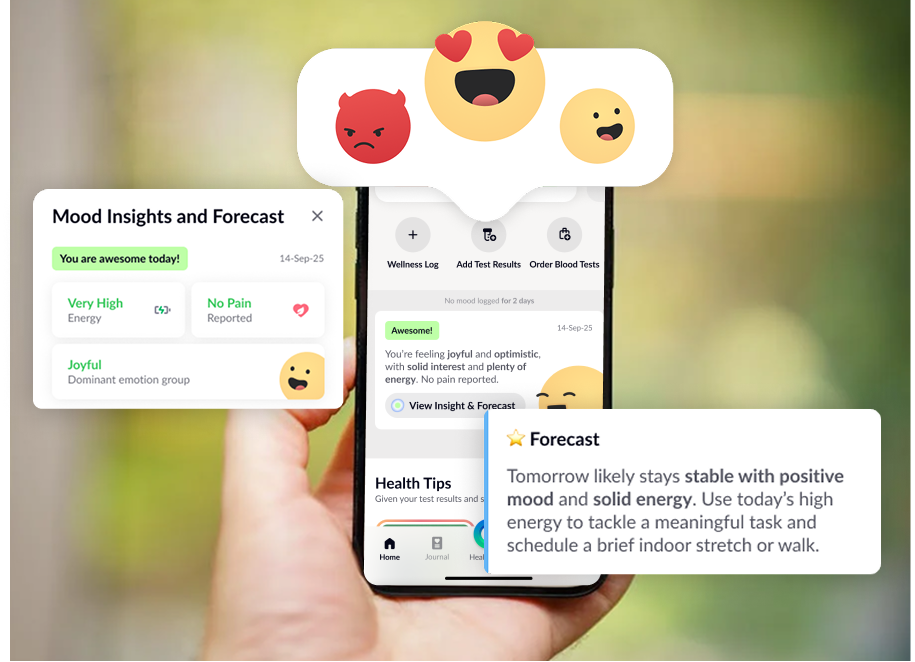A mood diary can be much more than a chart of “good” or “bad” days. When built on a mindful and science-based approach, it becomes a tool for understanding yourself on a deeper level. The right kind of mood diary helps you notice early signs of stress, emotional burnout, and mental overload — while uncovering the habits and factors that sustain your wellbeing. Let’s explore the three essential traits that make a mood diary truly effective: helping you develop emotional intelligence, recognize emotional patterns, and build resilience against stress. 1. Mood Diary Through Emotions — Learning to Understand Yourself The foundation of any mood diary lies in the way you assess your emotions. Most apps and journals offer a quick choice of smiley faces to describe how you feel — from “great” to “awful.” This method is convenient because it’s fast and simple. You can often add a short note or select factors that influenced your mood. So, what’s wrong with that? The problem hides in its very convenience. Choosing a smiley takes only a second — which means you rarely stop to reflect on what you actually feel. Without conscious reflection, you lose the main therapeutic benefit psychologists emphasize: you don’t learn to recognize and name your emotions. IN THIS ARTICLE 1 Mood Diary Through Emotions — Learning to Understand Yourself 2 Energy — The Key to Understanding the Depth of Emotions 3 Turning Observations into a System: The Two-Dimensional Mood Diary Model 4 🧭 How to Use the Mood Diary in Healsens Another issue with this quick approach is that people who tend to think in extremes (“everything is great” or “everything is terrible”) will see a distorted emotional picture in their mood diary. Over time, many of them give up tracking altogether because they can’t see the value. To move beyond such superficial evaluation, it’s better to record your mood by choosing specific emotions rather than faces. Why is an emotion-based mood diary more effective? Imagine trying to describe your “normal” day with a single smiley. You’d probably pick a happy face. But in emotional terms — does “normal” mean calm and peaceful? Or curious and joyful? Maybe it’s closer to tiredness, or even a hint of anxiety? When you start identifying and naming emotions, you naturally tune in to your body — noticing whether you feel tension, lightness, relaxation, or a subtle tremor. This is what true emotional awareness means: connecting your feelings with your bodily sensations. It’s also important to notice not only the dominant emotion but the quieter, background ones. That’s why a good mood diary should not only help you name your emotions but also mark their intensity. That’s when it becomes a tool for genuine self-discovery — allowing you to recognize recurring emotional patterns and understand which emotions you experience most often. These observations can later serve as a valuable foundation for conversations with a psychologist or therapist. Why Healsens? Healsens — a Smart Approach to Longevity Harness technology to extend your healthspan: biomarkers, risk assessment, and personalized recommendations—all in one place. 🔗 Download Healsens and take control of your health today. 📍 An emotion journal works as: – a tool for self-reflection, helping you externalize your experiences, look at them from a distance, and begin an honest dialogue with yourself;– a way to notice the first signs of emotional burnout before they escalate;– a practice of emotional acceptance, teaching you to experience and process emotions instead of suppressing them — reducing the risk of anxiety and depression;– a path to holistic awareness, where over time, your entries stop being just notes of pain or quick judgments and start reflecting the full complexity of your emotional world. Psychologists call this the development of emotional literacy — the first step toward inner resilience. 2. Energy — The Key to Understanding the Depth of Emotions Mood is not just about emotions — it’s also about the energy with which those emotions are felt. Anxiety with high energy feels like inner agitation, restlessness, or the urge to act. But anxiety with low energy feels very different — it’s exhaustion, helplessness, or quiet panic when strength is fading. The same applies to joy: with high energy it becomes excitement and inspiration, while with low energy it transforms into calm contentment. That’s why it’s so important that your mood diary doesn’t only capture emotions but also helps you notice how energized you are at any given moment. This awareness deepens your emotional understanding and guides you toward the right recovery practices. When anxiety arises with high energy, your sympathetic nervous system switches to full alert.Your body perceives the situation as a threat: – cortisol levels rise,– adrenaline and insulin flood the bloodstream,– heart rate accelerates, muscles tighten, the body is ready to fight or flee. In this state, your body doesn’t need meditation or calming techniques — it needs to release the stored energy. Movement is the best medicine: walking, exercise, deep breathing with long exhales, or any physical activity that helps discharge tension. But anxiety with low energy is another story. Here, the sympathetic system is drained — cortisol may stay elevated or, conversely, drop too low, while the nervous system shifts into energy-saving mode. You might still feel anxious, but without the strength to act — as if everything has slowed down and your thoughts remain restless, yet you can’t bring yourself to move.This is your body’s biological signal: your resources are running out. In this case, physical exertion will only worsen the fatigue. What you need instead is restoration:gentle breathing practices, meditations such as Kirtan Kriya, supportive social contact, rest, restorative sleep, and nourishing food that replenishes your energy. 📍 Key takeaway:By tracking how your energy level changes throughout the day, week, or month, you can begin to see when you feel most active and when you’re depleted — and learn to choose the right self-regulation practices. This kind of awareness, supported by a well-designed mood diary, helps prevent burnout, manage stress mindfully,



